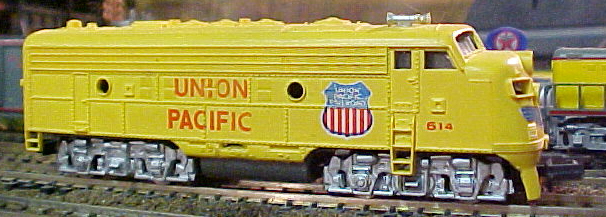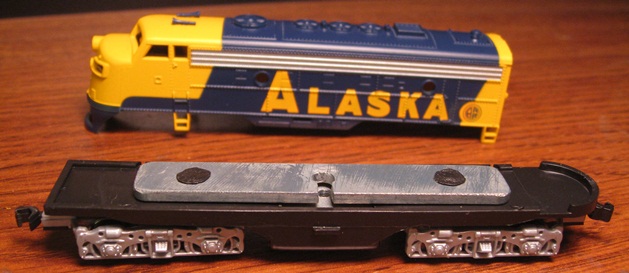

Introduced: 1968, revised 1971 and 1983 (and probably a bunch more times, but I'm sticking with these three dates)
As mentioned above, this locomotive has undergone numerous revisions since its first release (none of which are documented particularly well, so I'm just kind of making this up as I go along). Anyway, after spending a good long time purchasing various F9's off of eBay, I've come to the conclusion that there have been three basic mechanisms and two basic shell designs.
The initial release (1968-1970) has a larger shell than any of the subsequent versions. It features a rather primitive mechanism that sports one of the most godawful giganto-huge motors I've ever seen in an N locomotive (the bottom mechanism in the above picture). In addition to the white-metal mechanism, the other "spotting" feature of this model is the back edge of the roof, which comes to a point (bottom-most shell pictured above). During this same era, both dummy A and B units were also available (all featuring the extra-large shells with pointy-edged roofs). Powered A units seem particularly scarce these days, as it took me many months to finally locate one. Given the cheap mechanism, I suppose most of them are moldering in landfills these days. B units were only produced under this initial design (and as far as I know, they were all dummies).
The next version emerged circa 1971. It came with a smaller shell and a black-metal chassis with a white-metal top (the middle mechanism pictured above). The major spotting feature is the rounded metal fuel tank, stamped "Bachmann Hong Kong" on the bottom.
In 1983, Bachmann re-released this locomotive with yet another revised mechanism, this time featuring an angular split-frame chassis, new truck side frames (with the outermost brake shoes absent), and traction tires. The words "Bachmann" and "Hong Kong" (or "China") are visible on opposite sides of the fuel tank. The earlier mechanisms had wires soldered in place to conduct electricity, whereas the split-frame design of this new chassis eliminated the need for wiring.
Performance on this version isn't too bad, actually. Throttle response is decent, slow speed performance is fine, pickup through turnouts is good, and the sound, though louder than say a modern Kato or Atlas diesel, isn't particularly deafening. But come on, the traction tires on the rear axle make for a pretty wobbly ride. And then there's the filament bulb with the cat whisker wires, the truck-mounted Rapidos, the crummy paint and... well, y'know, regardless of the version, they're all Bachmann trainset crap. Apart from collectors, I can't imagine anyone being interested in acquiring and running any of these on a model railroad.
Update - circa 2012, a capacitor was added to the top of the chassis (for whatever reason) and the couplers were changed over to one-piece knuckles. Apart from the gearing (now black plastic), everything else is the same as it was in 1983 -

2012 Bachmann trainsets also come with dummy A units. The trucks are free-rolling and extremely primitive (being basically freight car trucks). As pictured below, the dummy truck sideframes are very different from the sideframes on the powered units -

The first version (1968-1970) came in a white and clear plastic box with the locomotive sitting upright and held in place with a screw. These same first generation models were also available in "Parkway Industries" packaging (some sort of Bachmann subsidiary). Same box, same models, different brand name. The second version came in a yellow and black plastic box (1970-1975) or a blue and white plastic box (1975-1983). The third version came in a white cardboard box (1983-2001) or a plastic jewell case (2001-present). All dates are approximate.
These models are available to this day, lurking in cheapie Bachmann trainsets and whatnot. The most recent versions sport crazy metallic colors that are straight out of the Mattel pallet.
Do not confuse any of these with the more recent (and vastly superior) F7 A and B units that Bachmann released under their "Plus" and (more recently) "Spectrum" labels.
Grade: C (and maybe, almost, kinda, sorta a "B" for the newest version. Well, a C+ anyway).